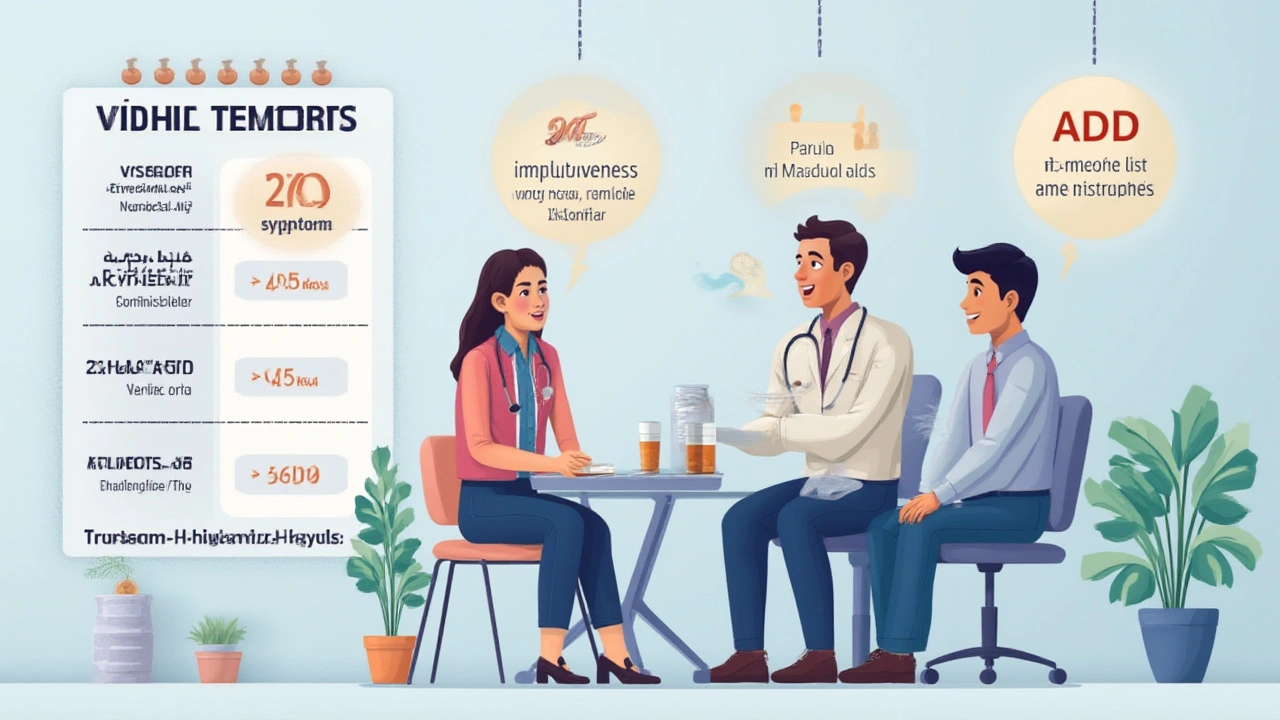ADHD vs. ADD: Exploring Key Differences, Symptoms, and Diagnosis

It’s weird to think that letters can change lives, but for millions of people, swapping ‘H’ for ‘D’ in a diagnosis of ADHD or ADD does exactly that. Parents, teachers, even doctors sometimes fumble over the terms. But when it’s your child, your partner, or even yourself that’s caught between ‘attention deficit’ and ‘hyperactivity,’ the confusion is more than just annoying — it can shape your path to getting help.
Breaking Down ADHD and ADD: What Do They Really Mean?
First up, let’s set the record straight about the two big acronyms. ADHD stands for Attention Deficit Hyperactivity Disorder. ADD means Attention Deficit Disorder. It sounds like ADD is just ADHD minus the fidgety energy, right? Sort of — but there’s more to it. The term ADD actually isn’t used much anymore. In 1987, the American Psychiatric Association rolled both conditions together under “ADHD.” That’s what you’ll see in modern medical guides. But here’s the twist: people (especially adults) still talk about ADD, usually to describe trouble with attention when the person isn’t particularly hyperactive.
ADHD itself is now split into three main “types,” or presentations:
- Predominantly inattentive (what people often call ADD)
- Predominantly hyperactive-impulsive
- Combined type
It’s all under one umbrella — ADHD. But which “presentation” someone has depends on which symptoms are strongest. Researchers say about 4-5% of adults around the world live with ADHD, though most aren’t diagnosed until later in life. In Irish studies, ADHD touches about 6.4% of kids. That’s more than one in twenty, with boys typically diagnosed more often, but many believe girls just slip through the cracks because their symptoms are less obvious.
Here’s a table to summarise the diagnostic shift:
| Term | Year Updated | Current Medical Use? |
|---|---|---|
| ADD | Before 1987 | No |
| ADHD | Since 1987 | Yes |
Symptoms: Why ADHD and ADD Feel So Different
This is where things get interesting. ADHD isn’t just about forgetting your keys or interrupting in conversations. The symptoms show up differently in everyone, and sometimes, it’s not like what you see in movies or TV shows. Let’s break it down:
- Inattentive Type (the old “ADD”): These folks have a tough time staying focused, they lose things, daydream a lot, and make “careless mistakes.” They aren’t always climbing the walls. Instead, their minds wander off, especially when things get boring.
- Hyperactive-Impulsive Type: This group can’t sit still. They fidget, talk non-stop, jump from one task to the next, and sometimes act before they think.
- Combined Type: People have enough symptoms from both groups to fit in both categories.
For adults, the signs can get sneakier. Hyperactivity often morphs into a restless “inner buzz,” or just constant multitasking. Chronic lateness, disorganization, battling distractions, and forgetting what someone just said? Classic signs, but often dismissed as personality quirks.
There’s a stereotype that ADHD means you’re bouncing off the walls, but many kids (and adults) just zone out. Girls, in particular, get labelled forgetful, dreamy, or even lazy. They’re much more likely to have the inattentive presentation, and studies show lots of women don’t get diagnosed until after their own children are evaluated.
If your child can't finish homework, or you keep losing your phone, it could be ADHD. But it could also be stress, sleep deprivation, or just being overwhelmed. Only a proper assessment can tell for sure, so don’t self-diagnose lightly.

Getting Diagnosed: What the Process Actually Looks Like
Getting diagnosed with ADHD is rarely a quick thing — and it’s definitely not as simple as ticking a few boxes on an online quiz. Doctors look for symptoms that:
- Start before age 12 (according to the DSM-5, the current “rulebook”)
- Show up in more than one setting (school and home, for kids)
- Make life noticeably harder — academically, socially, at work, or at home
Expect a mix of interviews, questionnaires, sometimes even reports from teachers or partners. You can be smart, driven, and successful, and still have ADHD. Lots of high performers wrestle with it in silence, coming up with clever ways to “mask” symptoms. But here’s a truth bomb: getting a diagnosis can feel like a relief, not a sentence.
Kids usually get flagged by teachers who spot classic patterns: struggling to follow instructions, missing assignments, interrupting class. Adults, on the other hand, often seek help after a “crash” — a failed project, marriage trouble, or when their child gets diagnosed and the penny drops for themselves.
About one in four kids referred for “possible ADHD” in Ireland don’t actually get that diagnosis — they might have anxiety, trauma, or another explanation. That’s why a thorough process matters.
Practical Tips for Living with ADHD or ADD Traits
So, what helps if you or your loved one fits in the ADHD camp? Medication is one option and often gets the spotlight, but it’s not the only answer. Cognitive behavioral therapy (CBT), coaching, and tailored routines matter just as much.
- Use visual supports. Sticky notes, whiteboards, color-coded calendars — anything to keep important info front and center.
- Chunk tasks. Breaking big jobs into bite-sized steps makes them less overwhelming and easier to finish.
- Set timers. Short bursts of focused effort (like the Pomodoro Method — 25 minutes on, five off) can be a game changer.
- Build routines. Pair everyday tasks with something enjoyable. Listen to a podcast while folding laundry, or play music during chores.
- Minimize distractions. If you’re working from home, noise-cancelling headphones can be a secret weapon.
- Forgive yourself. Messy doesn’t mean lazy. Self-blame helps no one.
For families, understanding is key. ADHD brains respond best to structure, encouragement, and reminders rather than nagging or punishment. Positive attention works wonders. And if you’re working with schools, push for supports like extra time, oral instructions, or movement breaks — they make a real difference. One Irish survey found students with ADHD are more likely to get excluded or suspended, so fighting for accommodations isn’t just helpful — it can be crucial for their future.
For adults, sharing your diagnosis (or at least your needs) at work can be freeing. More Irish workplaces are introducing neurodiversity initiatives, so you might find allies where you least expect them.

Common Myths, Facts, and Where Science is Headed
The internet is full of myths: “ADHD isn’t real,” “just an excuse for bad behaviour,” “a kids’ problem,” or “caused by eating too much sugar.” None of these hold up under scrutiny. Brain scans show differences in the structure and activity of regions tied to attention and impulse control. Genetics play a huge role — if a parent has ADHD, their child has over a 50% chance of having it too. Environmental factors (think premature birth or lead exposure) can also up the risk, but you can’t ‘catch’ ADHD later in life.
There’s no blood test or brain scan to ‘prove’ ADHD — it’s diagnosed by understanding patterns in behaviour and function. But researchers in Dublin and beyond are looking at digital tools, like computer-based tests and even smartphone tracking, to make diagnosis fairer and faster. Already, wearable devices are showing promise to track attention lapses, but for now, a skilled clinician is still your best bet.
If you’re worried about medication, here’s a fact: stimulant meds like methylphenidate or amphetamine are among the most researched psychiatric treatments. For most, they’re safe when used as prescribed. But they aren’t magic pills — therapy, lifestyle tweaks, and support networks matter just as much. And about 30% of people don’t respond to the first medication they try, so expect trial and error.
ADHD in adults is finally getting the attention it deserves. In Ireland, more clinics are popping up, waitlists are shrinking, and awareness campaigns are everywhere — but sadly, many families still have to push for recognition. With better understanding, early support, and some creative workarounds, ADHD (or ADD, if you’re still attached to the term) doesn’t have to steal anyone’s potential.

Miriam Lohrum
July 23, 2025 AT 13:49It’s wild how language shapes reality. The shift from ADD to ADHD wasn’t just a rename-it erased a whole way of experiencing the world. People who never fidgeted but spent their lives feeling like they were underwater? They got folded into a category that still screams ‘hyper.’ The word ‘disorder’ itself feels like a cage. What if we called it ‘neurological variance’ instead? Less pathologizing, more humanizing.
It’s not about fixing brains. It’s about redesigning environments to fit them.
archana das
July 24, 2025 AT 23:52In India, ADHD is still seen as ‘bad parenting’ or ‘too much screen time.’ No one talks about brain chemistry. I had a cousin who couldn’t sit still in class-teachers called her ‘chatterbox.’ She dropped out at 15. Now she’s a brilliant artist who paints for 12 hours straight but can’t pay bills on time. We need to stop blaming and start understanding. ADHD isn’t a flaw-it’s a different operating system.
And yes, I still say ‘ADD’-because my brain remembers the quiet version of me before the label changed.
Emma Dovener
July 25, 2025 AT 07:40Just wanted to add: the myth that ADHD only affects kids is dangerous. I was diagnosed at 38 after my daughter got evaluated. My whole life, I thought I was just ‘lazy’ or ‘disorganized.’ Turns out I’ve been running on adrenaline and caffeine for two decades. The relief was physical. Medication didn’t fix me-it gave me back the bandwidth to think clearly. Also, Pomodoro method saved my career. Try it. It’s not magic. It’s math.
Sue Haskett
July 26, 2025 AT 19:16Can I just say-please stop calling it ‘ADD.’ It’s not a cute nickname. It’s not a throwback. It’s outdated terminology that actively harms people trying to get help. The DSM-5 updated it for a reason. Using ‘ADD’ makes people think they’re not ‘real’ ADHD. And that? That delays diagnosis. Especially for girls. Especially for women. Especially for people of color. Stop romanticizing the past. Start using the science.
Jauregui Goudy
July 28, 2025 AT 07:53Let’s be real-ADHD isn’t some quirky personality trait. It’s a neurological condition that wrecks lives if ignored. I’ve seen people lose jobs, marriages, entire decades because someone said, ‘You’re just distractible.’ No. You’re neurodivergent. And you deserve support, not shame. I used to think I was lazy. Then I got diagnosed. Now I run a business. The meds? They didn’t change me. They let me be me. Without the fog.
Stop gaslighting yourselves. Get tested. You’re not broken. You’re just wired differently. And that’s okay. In fact? It’s powerful.
Rhiana Grob
July 30, 2025 AT 05:55Thank you for writing this. So many of us grew up being told we were ‘spacey’ or ‘unmotivated.’ I didn’t know my brain worked differently until I was 32. Now I use color-coded calendars, voice memos for reminders, and I schedule ‘wander time’ because forcing focus just makes me shut down. The most important thing? I stopped apologizing for needing structure. It’s not weakness. It’s strategy.
Also, if you’re a parent-don’t wait for a teacher to flag it. If your child zones out during quiet tasks, they might be inattentive-type ADHD. Not lazy. Not defiant. Just different.
Frances Melendez
July 31, 2025 AT 21:27Look. I’ve seen too many people use ‘ADHD’ as an excuse to be irresponsible. ‘Oh, I forgot my keys because I’m neurodivergent.’ No. You forgot your keys because you’re careless. Stop weaponizing mental health labels. Medication isn’t a free pass to be disorganized. Discipline still matters. If you can’t manage your life, maybe it’s not the brain-it’s the choices. And don’t get me started on ‘ADHD coaches’ charging $200/hour. This isn’t a lifestyle brand. It’s a medical condition. Treat it like one.
Jonah Thunderbolt
August 1, 2025 AT 19:31OMG I’m literally crying rn 😭😭😭 I’ve been diagnosed since I was 8 and everyone still thinks I’m ‘just a hyper kid’ 🤦♀️ I’m 34 and I still cry when I lose my keys because my brain doesn’t save locations like a normal person 😭 I use 7 apps to track my phone, 3 alarms, and I’ve named my sticky notes 😂 But guess what? I just got promoted. My ADHD brain sees patterns no one else does. I don’t need to be ‘fixed.’ I need to be understood. And if you’re still using ‘ADD’? You’re part of the problem. 🚫 #NeurodiversityIsntAChoice
Rebecca Price
August 1, 2025 AT 20:06Frances, your comment is exactly why we need more compassion, not more judgment. People don’t use ‘ADHD’ as an excuse-they use it as a lens to finally understand why they’ve struggled for decades. You think discipline fixes everything? Try disciplining someone whose brain literally can’t hold a thought long enough to start a task. That’s not laziness. That’s executive dysfunction.
And Rebecca? You’re right. The ‘ADHD coach’ industry is messy. But so is the medical system that took 27 years to diagnose me. Maybe the problem isn’t the coaches-it’s that we’ve spent 40 years telling people to ‘just try harder.’
Let’s stop shaming people for trying to survive in a world not built for them. And yes-I still say ‘ADD’ sometimes. Because sometimes, the old word feels truer to the quiet, invisible version of me.